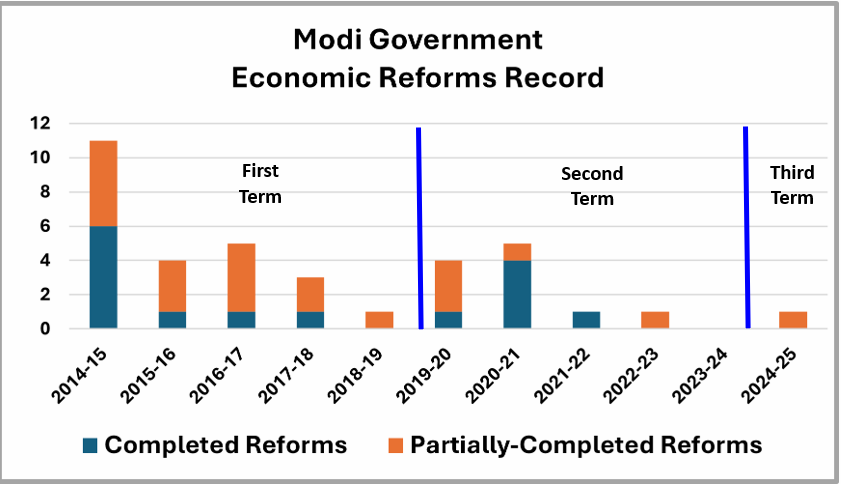It is never a bad time for big reforms. Especially when India’s business image can use a shot in the arm. But the recent India-Pakistan flare-up served as a reminder that, while India enjoys relatively high projected growth rates, investors have several options when looking at changes to global supply chains. The Modi government’s third term has largely been devoid of significant reforms compared to its first two terms, as we track in our India Reforms Scorecard. Finance Minister Nirmala Sitharaman laid out some very good ideas in her February 1 Budget Speech. It is time to follow up ideas with actions.
The ideas are not yet translating into a landslide of new foreign investment. According to the Reserve Bank of India (RBI), India drew in only $52b in foreign direct investment (FDI- “equity”) over the last 12 months. While this is a 16 percent year-on-year increase, it is still equal to the average annual FDI over the last 5 years. The terror attack in Kashmir on April 22 and the ensuing conflict between India and Pakistan reminded the world that India, like the United States and other partners, remains a target for extremists and state actors. India’s continued goods trade deficit reinforces the Modi government’s protectionist instincts on trade, beyond the trade agreements signed with a few trade partners.
When the Modi government was first elected in 2014, we created the first iteration of our India Reforms Scorecard— a list of 30 big reforms that economists, business leaders, and other specialists want to see the government undertake. As you can see from the chart below, the first year of Prime Minster Modi’s first term was extraordinarily productive in terms of enacting—sometimes even imperfectly— the reforms we track. In the first year of the government’s second term, we saw four positive steps.
In the first year of the government’s third term, the government has only initiated a single partial reform. And that, too, was actually the Reserve Bank of India, and the Securities and Exchange Board of India outlining a formal, coherent process for setting new regulations.

The government of India has laid out some significant reform ideas. Notably in her February 1, 2025 Budget Speech, Finance Minister Nirmala Sitharaman announced that the government would further lift the FDI cap in insurance, creating a high-level committee to review the business-friendliness of new regulations, creating a new “investment-friendliness index of states,” and more. Not all of these measures are part of our list of 30 reforms on the India Reforms Scorecard—but they would be heartily welcomed by domestic companies and foreign investors alike.
Obviously, the Modi government was politically weakened by last year’s election. It no longer has a single-party majority. Other parties— notably the Telugu Desam Party (TDP) and Janata Dal United (JD-U)— have stronger voices in influencing policy. However, in my experience, TDP is perhaps more supportive of reforms than the BJP. And the JD-U is relatively agnostic on reforms. Therefore, both can be net positive forces.
The world is an increasingly wild and unstable place. Investors are looking for a mix of growth, stability, and a business-friendly regulatory environment. India does well on the first parameter; the recent conflict with Pakistan raises concerns on the second. But the government can do better on the third. Success will result in job creation, more secure supply chains, an improved balance of trade, and more prosperity for India—and partners like the United States.
(The article was published by the Center for Strategic and International Studies (CSIS), on May 19, 2025. South Asian Herald republished it with permission from CSIS.)
Disclaimer: The opinions and views expressed in this article/column are those of the author(s) and do not necessarily reflect the views or positions of South Asian Herald.






